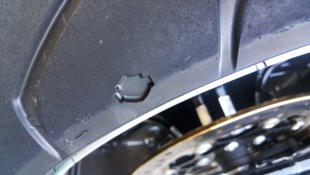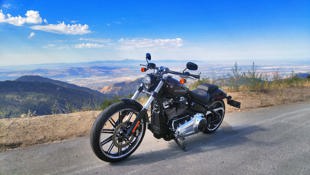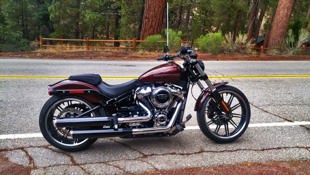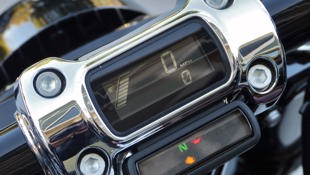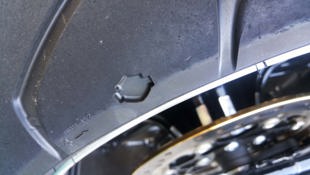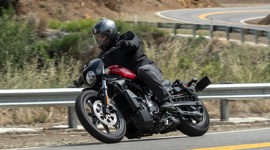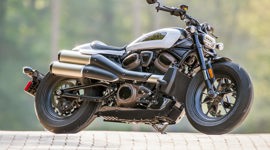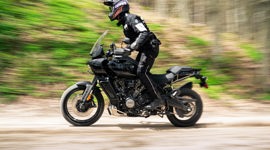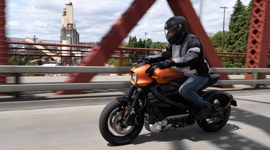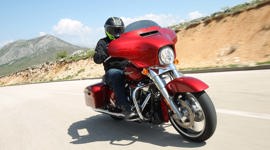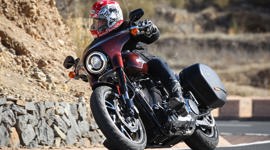The twin-shock is dead. Whether it’s exposed, like in the Harley-Davidson Dyna line-up, or tucked away, as in the Softail line-up, the dual-shock rear suspension system is gone.
The new single-shock chassis design means a dramatic reduction in weight, and even more importantly for people like me… a large increase in ground clearance.
In its place, there’s a new, hidden mono-shock that makes up the “soft” in the new Softail range. There’s no more Dyna, but you can still get former Dyna models Fat Bob, Street Bob, and Low Rider. Only now, they’re Softails, not Dynas.
The consolidation of the two iconic Harley-Davidson lineups represents the first major chassis design change for that crop of bikes since 1984. The new single-shock chassis design means a dramatic reduction in weight, and even more importantly for people like me… a large increase in ground clearance.
The decision to merge the two lines came mostly from consumer feedback – Harley-Davidson noticed a lot of overlap between what shoppers wanted, and how they saw the bikes, within the two product lines. So, with the understanding that some of their bikes were simply too similar, Harley-Davidson set out to redesign its volume-sellers.
There are two frames – though mostly the difference is in the swingarm and swingarm mount. That change is for the Breakout and Fat Boy in order to accommodate the steamroller wheel that stands in as a rear tire for those two units. All other models get the same narrow frame, but with three different steering angles. Those frames now have 50 percent fewer separate components and 22 percent fewer welds, making for a 90 percent increase in stiffness. The narrow frame is 20 percent lighter, the wide frame 15 percent.
The oil pan has been moved from up high under the seat to down low, under the engine, further enhancing the chassis by better distributing weight. Significant work has been done on the suspension too, with up to 100 percent more range of preload adjustment, which on some models can be accomplished with an easy twist knob on the right side of the bike.
The front end has a new Dual Bending Valve system from Showa on all but the Fat Bob. That model gets proper racing-style cartridge forks. The Dual Bending Valve system is an insert that gives the fork increased range of damping. Beyond that, it’s all suspension voodoo to me.
Peg position is always forward, but some are set farther than others. And of course, H-D being H-D, there are thousands of combinations of handlebars, seats, pegs, levers, and other accessories to differentiate models. It’s fair to say that your chances of stumbling on a Softail exactly like yours are slim to none.
The two Milwaukee Eight engines in 107 ci (1,753 cc) and 114 ci (1,868 cc) arrive out of the box with 93 hp/110 lb-ft and 100 hp/119 lb-ft respectively, but upgrade kits are available.
Going through all five stages of performance upgrade (which include a bump in displacement to 114 ci and 117 ci) nets as much as 120 hp and 118 lb-ft of torque in the 107 lumps, while the 114 is good for a max of 122 hp and 120 lb-ft of torque.
Honestly, the 114 engine in the units we rode felt like they pulled much harder than the 107, and that was before I glanced down to see which engine was in the tester I was on. The difference was stark enough, model to model, that some colleagues asked about gearing. Harley-Davidson says they’re all geared the same, and they all run out of puff around 6,000 rpm. These are big, lumpy, lazy engines that pull confidently from a rolling speed but won’t blow you away with power off the line.
The 45-degree V-Twin is a capable and iconic engine, but it’s worth noting that bigger output is available from less displacement elsewhere in the industry.
Still, nearly a 25 percent improvement in power-to-weight ratio can’t be sneezed at, and the 2018 Softail lineup is a massive improvement over the outgoing one.
And, after two days of hustling these cruisers through sport-bike country in the Californian mountains, I can tell you that the new Softails are genuinely fun to ride.
Doling out brutal abuse to the floorboards and feeler pegs, we back-to-back tested all eight Softail variants. So naturally, I had to rank them.
I've ranked the Softails from my least to most favourite below, but if you want the short answer: Get the Fat Bob.
2018 Harley-Davidson Softail Heritage Classic 107/114 ($22,999/$24,799)
My least favourite of the bunch, the Heritage Classic sported classic Harley-Davidson styling cues like studded bags, and a large windscreen. Sadly, that windscreen seemed to dump all of the turbulent air right at the top of my helmet visor, making for a loud, buffeting, and uncomfortable ride.
The screen and other accoutrements mounted up high and forward also made the Heritage Classic the least confident-feeling bike to toss about. Riding in relaxed settings the Heritage Classic would be nice without the non-adjustable windscreen, but otherwise the Heritage Classic is the least modern-feeling of the range.
My opinion was countered by a colleague, however, who claimed the Heritage Classic felt “most like what a Harley should feel like.”
It’s expensive too, coming in at the same price as the Breakout and Fat Boy. This edition is aimed solely at the tried and true, striking a path from the dealership to the garages of the Harley-Davidson faithful.
For everyone else, get the Fat Bob.
2018 Harley-Davidson Softail Slim 107 ($19,499)
Another callback to the history pages, the curved handlebars of the Softail Slim made me feel like I was about to try and jump a barbed-wire fence and escape into the distance.
Couple those elbows-in handlebars with the lowest seat height of any bike here at 660 mm, and the Slim feels tight ergonomically. The result is that the handling on this bike feels forced, and it’s difficult to settle into a rhythm, even on the more loping sections of road.
The Slim is a decent ride, falling easily into line with the other 107-equipped, narrow-frame Softails when it comes to turn-in, but perhaps as a result of those handlebars I found more bump-steer here than other offerings.
The ability for the Softail lineup to absorb road imperfections while cornering has increased dramatically with this upgrade, but on the Slim I still felt some front wheel shake and jounce. It made it more difficult to hold a consistent line. Again, the handlebars probably accentuated this feeling.
But, for being a little too cramped and a little too unsteady, I’d look past the Slim when shopping in this range.
And where most people will look first, is my fifth-placed offering….
2018 Harley-Davidson Softail Fat Boy 107/114 ($22,999/$24,799)
The first bike I experienced with the 114 engine in it, the Fat Boy endeared me with its forceful presence. Curb appeal is strong in this offering, and the retro-style upside-down forks harken back to the rocket-inspired design heyday that cemented Harley-Davidson as one of, if not the most famous brand in the motorcycle industry.
With only 25.6 degrees of lean angle the Fat Boy (like the Breakout) is most happy at a drag strip. Its massive 240/40R18 rear is paired with an equally chunky 160 mm front wheel, and the solid disc wheels add a big whack of unsprung weight. Total wet weight for the Fat Boy is second only to the Heritage Classic at 317 kg. Yes, this is the big-daddy of the paddock.
The handlebars are moderately high, but you can expect that this is the bike where owners will take prime advantage of Harley-Davidson’s innovative two-piece cable routings for the clutch and throttle. That bit of engineering is a nod to the wild and extreme modifications Harley-Davidson owners are prone to making to their machines – particularly in the handlebar department.
With the same 30-degree rake as most of the lineup, the Fat Boy is less aggressive than the Breakout in terms of stance, but it’s still an imposing unit. The remote preload adjustment will make life easy for people who do a lot of two-up riding and the floorboards were more comfortable than I expected – even if they did spend a disconcerting amount of time scraping up the tarmac.
Get the Fat Bob.
2018 Harley-Davidson Softail Breakout 107/114 ($22,999/$24,799)
The Breakout is a stunning-looking bike. While Harley-Davidson focuses on form above all else in almost everything it does, it takes that philosophy to the extreme here. Nestled in the handlebar risers is the minimalist digital gauge that Harley-Davidson execs proudly claim “looks illegal.”
A whopping 34 degrees of rake throw the front wheel way out front, stretching the wheelbase from the standard 1,630 mm to 1,695.
The seat drops to 665 mm and its lean-angle clearance at 26.8 degrees is second-lowest behind the Fat Boy.
Out back, a “kiss this” 240/40R18 tire. This steamroller-edition wheel shared with the Fat Boy hands out lessons in physics anytime you try to lean the Breakout into a corner. The chief lesson? “Lol, no. I don’t want to turn, thanks!”
Being an 18-inch wheel (to the rest of the range’s 16s) the Fat Boy and Breakout both suffer from a loss in the outright acceleration stakes. It takes more effort to get these up and running than the others. Here then, the difference between the 107 and 114 is more pronounced. In short, if you want the Breakout – get the 114. And then get all the upgrades to maximise power.
I love the Breakout for its street-brawler attitude – but it needs more power to back up that promise. So get the Fat Bob.
2018 Harley-Davidson Softail Deluxe 107 ($22,499)
If the Heritage is really “how a Harley-Davidson should be” according to my colleague, I wonder what his opinion of the Deluxe is. Because for me, the Softail Deluxe is what a Harley is meant to be.
Garish as an Elvis Impersonator and eye-catching in cherry red, complete with tombstone LED taillight, the Deluxe is by no means the shrinking violet of this group. And my gosh, is it fun to ride.
Stable, well-planted and solid, the Deluxe soaks up the bumps in the road with astonishing prowess.
The front feels hefty, and it wants to fall over into corners if you’re not careful. A lot of that 316 kg wet weight is definitely up front – but if you commit to counter-steering and sit back to enjoy the ride, the Deluxe is a wonderful cruiser. This would be my long-distance pick in a heartbeat.
But otherwise, get the Fat Bob.
2018 Harley-Davidson Softail Low Rider 107 ($18,999)
“Oh hello mid-mount foot pegs!” My first impression on getting on the Low Rider was those pegs. My short 5'6" frame abhors foot-forward controls, much preferring to keep my feet under me where I can peg-weight for steering. It also makes for a less disconcerting ground-out, where your feet and legs are in a more natural, less vulnerable position.
I don’t mind throwing a peg on the ground if it’s under the ball of my foot, but scraping my heel feels bizarre.
It’s those pegs that helped the Low Rider stand out as one of the better bikes to ride. I could leave the ancient-looking dual gauges on the tank behind, and have little love for the chrome explosion, but the Low Rider is a solid little option.
Except, get the Fat Bob.
2018 Harley-Davidson Softail Street Bob 107 ($17,999)
The Street Bob is easily the most surprising of all the Softails for me, and at $17,999 it represents a compelling value proposition. Sure, you can only get it with the 107 engine, but I don’t think most people will mind.
The high-rise ape-hanger bars were surprisingly comfortable at speed, and I found myself grinning wide as I used them to counter steer the little Bob in chase of the lead rider in our group over the Angeles Crest. The digital riser gauge is far superior to the tank-mounted dials on all the other models save the Breakout, and help set this bike off aesthetically too.
Like the Low Rider, the Street Bob’s foot controls are set back a little further than the others, making for a more conventional riding position which I enjoyed.
It’s the lightest Softail at 296 kg and the Street Bob feels as stripped-back and easy-to-ride as its laced wheels and simple lines suggest. For less than $18,000, it’s hard to find a better buy in this catalogue.
Hard – but not impossible... and you probably know where this is going now....
2018 Harley-Davidson Softail Fat Bob ($21,299/$22,799)
The Fat Bob is the modern man’s (or woman’s) Harley. The cartridge-style suspension felt the best of all the Softails when it came time to throw it around, and I really enjoyed the twitchy, almost nervous chassis.
The Fat Bob is a bargain too. At $21,299 for the 107 it is the third-least expensive of the crop.
At $22,799 for the 114 it’s only $300 more expensive than the 107-equipped Softail Deluxe, and $500 less than the 107 editions of the Fat Boy, Breakout, and Heritage Classic. For that money you get dual-disk front brakes (the only model to get them) plus the best-looking exhaust.
Those brakes were stronger than the others to the point it was making the back end light in surprising ways, leading many in our group to complain that the back needed settling down on corner entry. I disagreed, feeling that the lively chassis was the Fat Bob’s biggest attribute.
The Fat Bob is the only Softail with a 28-degree steering head angle, with all others bar the Breakout (34 degrees) getting the 30-degree unit. The result is the shortest wheelbase at 1,630 mm – further enhancing its agility. The wide, flat bars are excellent for confidence and control. Ergonomically, this bike excels.
A monstrous (for a Cruiser) 31 degrees of lean angle is 1.5 degrees more than the Low Rider gets and 2.5 degrees better than the entire rest of the lineup.
Put it all together and you’ve got a Softail that outperforms the others by a wide margin, even with its strange choice in tires.
Here we see Harley-Davidson’s incessant focus on form, which is why the Bob has those adventure-style touring tires on it. They give it a tough, retro-thug look but honestly they’re the one area the Fat Bob is let down. If I was going to throw down money on a Softail this is where I’d spend it – but I’d immediately put down $500 on a set of a better tires too.
The only other thing on my Fat Bob wishlist is the trick digital instrument cluster from the Breakout, because it sets off the lines nicely.
Once appropriately tired, the Fat Bob is absolutely the pick of this excellent new Softail lineup.
Pricing: 2018 Harley-Davidson Softail Lineup
By Price:
2018 Harley-Davidson Softail Street Bob: $17,999
2018 Harley-Davidson Softail Low Rider: $18,999
2018 Harley-Davidson Softail Slim: $19,499
2018 Harley-Davidson Softail Fat Bob: $21,299
2018 Harley-Davidson Softail Deluxe: $22,499
2018 Harley-Davidson Softail Fat Bob 114: $22,799
2018 Harley-Davidson Softail Breakout: $22,999
2018 Harley-Davidson Softail Fat Boy: $22,999
2018 Harley-Davidson Softail Heritage Classic: $22,999
2018 Harley-Davidson Softail Breakout 114: $24,799
2018 Harley-Davidson Softail Fat Boy 114: $24,799
2018 Harley-Davidson Softail Heritage Classic 114: $24,799
By Model:
2018 Harley-Davidson Softail Breakout: $22,999
2018 Harley-Davidson Softail Breakout 114: $24,799
2018 Harley-Davidson Softail Deluxe: $22,499
2018 Harley-Davidson Softail Fat Bob: $21,299
2018 Harley-Davidson Softail Fat Bob 114: $22,799
2018 Harley-Davidson Softail Fat Boy: $22,999
2018 Harley-Davidson Softail Fat Boy 114: $24,799
2018 Harley-Davidson Softail Heritage Classic: $22,999
2018 Harley-Davidson Softail Heritage Classic 114: $24,799
2018 Harley-Davidson Softail Low Rider: $18,999
2018 Harley-Davidson Softail Slim: $19,499
2018 Harley-Davidson Softail Street Bob: $17,999
